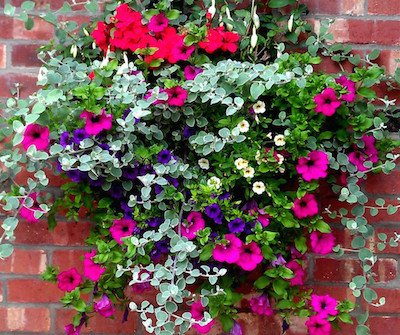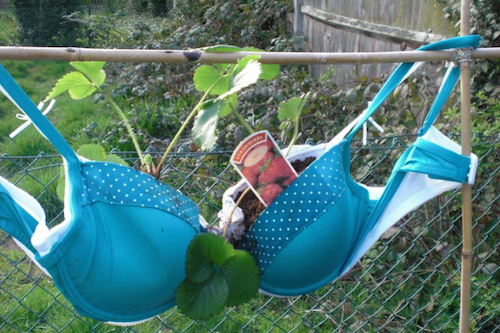Secrets to success….Hanging Baskets
With Horticulturist Gareth Austin
A hanging basket full of colour, in the peak of summer sunshine is a joy to behold.
Whether its a set of them either side of the front door, one on the side of the shed or the front of a B&B smothered in them in Westport. Hanging baskets are real eye catchers, but it doesn’t happen overnight!
The creation of and maintenance of a great hanging basket takes a bucket load of effort and the majority of it in lifting watering cans!
Here’s a few of my tips on creating amazing hanging baskets
Step 1
Size. Yes it matters. The bigger a basket you put up the less you have to water it, due to the larger volume of compost it holds. This compost works like a sponge, absorbing water and nutrients for the plants to utilise later. Smaller baskets need watering more often and in turn waste more fertiliser as a lot of goodness leaches out the bottom of the basket when you’re doing all this extra watering….try to use at least a 16” basket.
Step 2
Compost Selection. A vital step in the process. The hanging basket is a completely fixed space for plant roots to grow into, so it’s important the root zone area is filled with the best of compost you can source. A high quality John-Inness enriched multi-purpose compost is ideal for this. Old compost from last year should never be reused in baskets, throw this out onto the flower beds in the garden or add it to the compost heap.
Step 3
Fertiliser.
When your planting always mix in some controlled release fertiliser into the potting mix. This is wonderful stuff, its wee balls you mix through the compost and over a period of 6 months it slowly releases complex nutrients to the plants as they need them. Then you can ‘boost’ the basket if you need to, say after a batch of wet weather, with a wee dose of tomato food (or better still make up some Comfry feed and use this – we’ll chat more about this next week). Many hanging baskets don’t flower as much, and produce too much foliage due to over feeding….so the controlled release fertiliser is highly recommended
Step 4
Watering. Hanging baskets need watering. But yeah, with a bigger basket you’ll water them less, but they’ll still need watering…even when its raining! The lip around house roofs sometimes mean that little rain actually lands in the basket, also the wind is a constant drying effect. Always water in the morning, as early as you can, but certainly before it starts to get warm. Watering in warm weather wastes your time, as a third of the water can simply evaporate. Water baskets every morning, and try to avoid getting the plants unnecessarily wet. We drink next to nothing through our skin, neither do plants, so water soil not leaves! Watering can be reduced by mixing in some water storing granules through the potting mix. Wet foliage and wet flowers spread pests and diseases.
Step 5
Deadheading. Short lived annuals are designed to reproduce seeds as quickly as possible, and when they’ve done this they die off. So by removing old flowers you not only keep the baskets looking great, but you encourage the plants to produce more flowers for a much longer period. Dead heading should be carried out at least weekly.
Step 6
Plant Choice. Planting all the same type of flower in a basket is like putting all your eggs in one basket. Its its good its good, but if the weather doesn’t favour that plant then the whole basket looks inferior Commonly the case with basket planted full of just trailing petunias. Instead choose a range of plants, with contrasting flower sizes and foliage colours. Add in some silver Nepeta, some golden Helichrysum, some small flowered Bacopa to go with your large flowering Surfinia. Or….why not try an edible hanging basket??
Step 7
Pests & Diseases. If you provide the plants with the correct amount of fertiliser, good compost and water them correctly you should not suffer from any particular pests or diseases. However we can also build in a wee bit of insurance into the basket with a few clever plants, try to include some Marigolds or Nasturtium into the baskets, these are great at attracting beneficial predators to the baskets (wee insects such as Hoverfly produce wee baby bugs which eat wee greenflys and the likes). Regular deadheading is a great way of keeping the baskets clean and mould free, watering in the morning reduces mould problems. But if you do get a dose of greenfly in the basket mix up some soapy water and give it a wee spray over the baskets. But prevention is better than a cure!
Next Week….Home made hotions and potions…
Gareth Austin is resident Horticulturist with BBC Radio Foyle, a member of the Chartered Institute of Horticulturists and lectures in Horticulture with Donegal ETB. For more see www.garethaustin.com or join Gareth on Twitter @GardenerGareth








